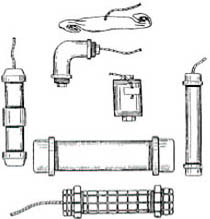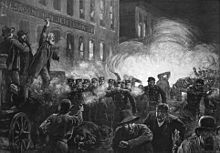Pipe bomb

A pipe bomb is an improvised explosive device, a tightly sealed section of pipe filled with an explosive material. The containment provided by the pipe means that simple low explosives can be used to produce a relatively large explosion, and the fragmentation of the pipe itself creates potentially lethal shrapnel.
Premature detonation is a hazard of attempting to construct any homemade bomb, and the materials and methods used with pipe bombs make unintentional detonation incidents common, usually resulting in serious injury or death to the assembler.[citation needed]
In many countries the manufacture or possession of a pipe bomb is a serious crime, regardless of its intended use.
Design

The bomb is usually a short section of steel water pipe containing the explosive mixture and closed at both ends with steel or brass caps. A fuse is inserted into the pipe with a lead running out through a hole in the side or capped end of the pipe. The fuse can be electric with wires leading to a timer and battery or can be a common fuse such as used in most consumer fireworks. All of the components are easily obtainable.
Generally high explosives such as TNT are not used, because these and the detonators they require are difficult to obtain. Such explosives also do not require the containment of a pipe bomb.
Instead, any sort of explosive mixture the builder can find or make is used, and some of the explosive mixtures used, such as black powder, match heads or chlorate mixtures are very prone to ignition by the friction and static electricity generated when packing the material inside the tube or attaching the end caps - accounting for many injuries or deaths amongst builders. If sharp objects, such as nails or broken glass, are added inside the bomb in an attempt to increase the amount of injury, these also add to the risk of premature ignition.[citation needed]
Operation
Pipe bombs concentrate pressure and release it suddenly, through failure of the outer casing. Plastic materials can be used, but metals typically have a higher bursting strength and so will produce more concussive force. For example, common schedule 40 1-inch wrought steel pipe has a typical working pressure of 1010 psi, and bursting pressure of 8090 psi[1], though the pipe sealing method can significantly reduce the burst pressure.
The pipe can rupture in different ways, depending on the rate of pressure rise, and the ductility of the casing material.
- If the pressure rise is slow, the metal can deform until the walls become thin and a hole is formed, causing a loud report from the gas release but no shrapnel.
- A rapid rate of pressure rise will cause the metal to act as a crystal and shatter into fragments, which are pushed outward in all directions by the expanding gases.
Modes of failure
Pipe bombs can fail to explode if the gas pressure buildup is too slow, resulting in bleed-out through the detonator ignition hole. Insufficiently tight threading can also bleed gas pressure through the threads faster than the chemical reaction pressure can rise.
They can also fail if the pipe is fully sealed and the chemical reaction triggered, but the total pressure buildup from the chemicals is insufficient to exceed the casing strength; such a bomb is a dud but still potentially dangerous if handled, since an external shock could trigger rupture of the statically-pressurized casing.
Uses
Pipe bombs are by nature improvised weapons, and typically used by those without access to military devices such as grenades. As well as users such as criminals, illegal paramilitaries and militias they also have a long tradition of recreational use for amusement or mischief with no intention to cause injury to anyone - but the dangers of premature ignition, and the inherent danger of shrapnel mean that when used in such a manner they are much more dangerous than alternatives such as dry ice bombs or spud guns.
Notable incidents

- On 4 May 1886, a gas-pipe bomb was thrown during a rally at Haymarket Square in Chicago, Illinois.[3] The gas-pipe bomb reached a police line and exploded, killing policeman Mathias J. Degan.[3] The thrown bomb was made from gas-pipe filled with dynamite and capped at both ends with wooden blocks.[3] Old nails were secured tightly by wire around the gas-pipe, which had a hole that received a fuse with a cap.[3] The event became known as the infamous Haymarket riots.
- On 20 October 1930, William Kogut, an inmate on San Quentin's death row, tore up ordinary decks of playing cards and used them to assemble a pipe bomb, which he used to take his own life.[4]
- On 27 July 1996 Eric Rudolph set up a pipe bomb which killed two people and injured 111 more in the Centennial Olympic Park bombing during the 1996 Summer Olympics in Atlanta, Georgia.[5]
- On 20 April 1999 Eric Harris and Dylan Klebold used pipe bombs during the Columbine High School massacre. They threw them around during their school massacre.[6]
- On 11 November 2001 an Ulster Defence Association (UDA) member was killed in Tigers Bay, Belfast, Northern Ireland when the pipe-bomb which he was preparing to use against a neighboring Catholic district exploded prematurely.[7][8]
- On 3 January 2002 a UDA member was killed in Coleraine, County Londonderry, Northern Ireland when the pipe bomb he was handling exploded prematurely during a Loyalist attack on a Catholic district.[9][10]
- On 23 May 2005 the Israel Defense Forces foiled a Palestinian pipe bomb attack at an army roadblock. The 14-year old Palestinian boy was carrying two pipe bombs on his belt.[11]
- Pipe bomb attacks were common during periods of heightened tension in Northern Ireland. On the night of 7 August 2005, two pipe bomb attacks targeted Catholics in the village of Cloughmills of North Antrim in Northern Ireland. The following day, Sinn Féin Councillor Daithí McKay accused loyalist paramilitaries of being behind the attacks.[12]
- On 10 August 2006, four pipe bombs were found in and around the city of Salem, Oregon, and some suspected a serial pipe bomber was at fault. First, a bomb was found attached to a car in the parking garage of Salem Hospital. Then one was located in the parking lot of a 'Roth's IGA' grocery store. Another was found attached to a car in a parking lot in Dallas, Oregon, and another found alongside a Salem roadway. The Salem Police Bomb Squad detonated the bomb outside the 'Roth's' and rendered the rest of the devices safe. The known victims were all residents of south Salem. Lonnie Troy Glinski, of Sweet Home, Oregon, was arrested and charged with multiple counts of attempted aggravated murder and possession of a destructive device.[13][14]
- On 12 September 2006, after an attack by militants on the U.S. Embassy in Damascus, Syria, a van was recovered, full of conventional pipe bombs strapped to small common household Liquefied Petroleum Gas canisters. The attackers appeared to have failed to detonate the bombs; however another smaller vehicle did explode outside the embassy during the late morning surprise attack.[15][16]
- On August 24, 2009, a former student was arrested after detonating two pipe bombs on the Hillsdale High School campus in San Mateo, California.[17]
- On May 10, 2010, a man used a pipe bomb to attack a mosque in Jacksonville, Florida. The bomb exploded while about 60 Muslims were praying in the mosque. The attack caused no injuries.[18]
- On August 27, 2010, 2 pipe bombs were located in the suburban area of 1700 block on Park Lane Ave. in McHenry Illinois. Cook County Bomb Squad was dispatched and defused both bombs before sending them to the crime lab. Investigations are ongoing.
- On September 6, 2010, a pipe bomb was picked up by an 8 year old child near St Comgall's Primary School in Ballymena Road, Antrim, Northern Ireland. This led to 2 schools being evacuated.[19]
- On December 11, 2010, a suicide bomber detonated one out of six pipe bombs close to a major shopping district in Stockholm, Sweden, killing himself with no other casualties. The incident is known as the 2010 Stockholm bombings.[20]
References
- ^ The bursting pressure below is based on Barlow's formula. The working pressure is based on factor 8. Dimensions are based on ASME/ANSI B36.10/19. http://www.engineeringtoolbox.com/wrought-steel-pipe-bursting-pressure-d_1123.html
- ^ "Act II: Let Your Tragedy Be Enacted Here, Moment of Truth". The Dramas of Haymarket. Chicago Historical Society. 2000. Retrieved 2008-01-19.
The details are factually incorrect, because by all accounts Fielden ended his speech before the bomb was thrown, and because the riot did not begin until after the explosion. In [this] depiction, the speech, the explosion, and the riot all take place at once.
- ^ a b c d Lawson, John Davison (1919). American State Trials: A Collection of the Important and Interesting Criminal Trials which Have Taken Place in the United States from the Beginning of Our Government to the Present Day. Thomas Law Books. p. 64.
{{cite book}}: Unknown parameter|coauthors=ignored (|author=suggested) (help) - ^ "Urban Legends Reference Pages: Death by Playing Cards". Snopes.com. 19 Jan 2007.
- ^ "Rudolph reveals motives". CNN.com. 19 Apr 2005.
- ^ "Columbine Massacre". About.com. 24 Aug 2006.
- ^ http://cain.ulst.ac.uk/sutton/chron/2001.html
- ^ "Police hunt loyalists after bomb death". BBC News. 12 November 2001. Retrieved 22 May 2010.
- ^ http://findarticles.com/p/articles/mi_qn4158/is_20020105/ai_n9670628.
{{cite news}}: Missing or empty|title=(help) [dead link] - ^ http://cain.ulst.ac.uk/issues/violence/deaths2002draft.htm
- ^ "Palestinian boy caught with bombs". Ynetnews. 23 May 2005.
- ^ "Pipe Bomb attacks on North Antrim Catholics". Sinn Féin's Peace Process Special. 08 Aug 2005.
{{cite news}}: Check date values in:|date=(help) - ^ "Pipe Bombs Found in The Salem Area". Salem-News.com. 13 Aug 2006.
- ^ "Salem Pipe Bomb Suspect Back in Court Tuesday". Salem-News.com. 13 Feb 2007.
- ^ "CNN.com - U.S. lauds Syrian forces in embassy attack - Sep 12, 2006". CNN. Retrieved 22 May 2010.
- ^ "In pictures: Syrian embassy clash". BBC News. 12 September 2006. Retrieved 22 May 2010.
- ^ "'Grave Damage' Averted at Hillsdale High School". KCBS. 24 Aug 2006.
- ^ "FBI Finds Pipe Bomb Used in Blast at Fla. Mosque". AOL News. May 12, 2006.
- ^ "Schools Evacuated As Boy Finds 'Pipe Bomb'". Sky News. September 6, 2010.
- ^ Sweden: Stockholm suicide bombings could have been 'catastrophic', The Telegraph
{{citation}}: Italic or bold markup not allowed in:|publisher=(help)
- US5,386,758–Apparatus and method for disarming pipe bombs
